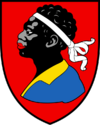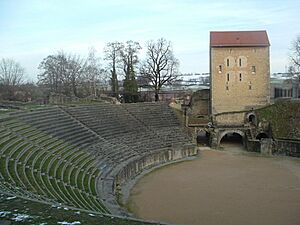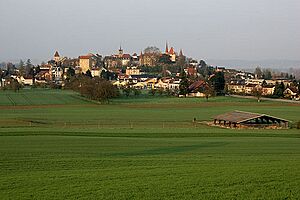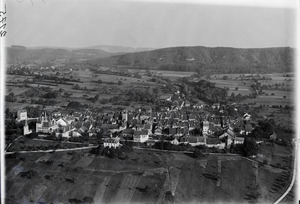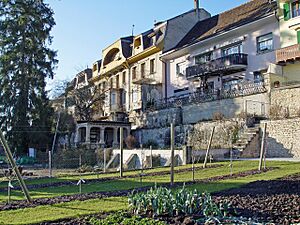Avenches facts for kids
Quick facts for kids
Avenches
|
||
|---|---|---|
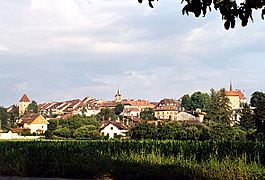
Avenches
|
||
|
||
| Country | Switzerland | |
| Canton | Vaud | |
| District | Broye-Vully | |
| Area | ||
| • Total | 19.47 km2 (7.52 sq mi) | |
| Elevation | 480 m (1,570 ft) | |
| Population
(Dec 2020 )
|
||
| • Total | 4,477 | |
| • Density | 229.94/km2 (595.55/sq mi) | |
| Postal code |
1580 Avenches
1582 Donatyre |
|
| Localities | Donatyre | |
| Surrounded by | Faoug, Villarepos (FR), Misery-Courtion (FR), Oleyres, Belmont-Broye (FR), Saint-Aubin (FR), Villars-le-Grand, Montmagny, Constantine | |
Avenches is a town in Switzerland. It is located in the canton of Vaud. This town is part of the Broye-Vully area. Avenches is well-known for its long and interesting history. It was once a very important Roman city.
Contents
History of Avenches
Avenches has ancient roots. It started with the Celts, a group of people who lived in Europe long ago. A Celtic tribe called the Helvetians built a settlement here. This was before the Romans arrived.
Around 15-13 B.C., the Romans built a new city. They called it Aventicum. This city became the capital of the Roman province. Its name came from Aventia, a Helvetian spring goddess.
Aventicum grew quickly. It became a busy trading center. More than 20,000 people lived there. The Roman emperor Vespasian helped the city grow. Aventicum was given "colonia status." This meant it was a special place for retired Roman soldiers.
The city had very long walls, about 5.6 kilometers (3.5 miles) long. These walls showed the city's importance. They were not just for defense. Archeologists have found many Roman buildings. These include a theater and a large temple. One column from the temple still stands today. It is called the "cigognier" because storks used to nest there.
Other Roman ruins you can still see include the amphitheater. This large arena now has a museum inside. You can also see parts of the Roman baths, walls, and gates.
In the 280s, the Alamanni tribe invaded this part of Switzerland. After the Roman Empire fell, a smaller town was built. It was on the site of the old Roman city. Avenches remained important as a bishop's seat. But when the bishop moved to Lausanne, the old Roman city declined.
In 1074, a new city was founded on the site. It was named Adventica, later becoming Avenche in 1518. A tower was built on the Roman amphitheater. This tower now holds the museum. The town gained city rights in 1259.
Avenches came under the rule of Bern in 1536. This happened when Bern conquered the Vaud region. Later, in 1803, Avenches became part of the canton of Vaud. It was made the capital of its district.
In 1910, an airfield was built near Avenches. This is where Ernest Failloubaz made a historic flight. It was the first flight in Switzerland by a Swiss-built aircraft. The airfield later served as a military airport. It closed in 1921.
Archeological digs of the Roman city began in the 1800s. These digs helped uncover many parts of the ancient city. They revealed a palace, the city center, and more.
Geography of Avenches
Avenches covers an area of about 17.56 square kilometers (6.78 square miles). Most of this land, about 63.4%, is used for farming. Forests cover about 15.8% of the area. Buildings and roads make up about 19.6% of the land.
The town is on a hill in the Broye valley. It is about 12 kilometers (7.5 miles) northwest of Fribourg. The village of Donatyre is also part of Avenches. In 2011, the nearby municipality of Oleyres also joined Avenches.
Coat of Arms
The blazon of the Avenches coat of arms shows a black Moor's head. It has a silver band around it. The head is dressed in blue and gold.
People of Avenches (Demographics)
Avenches has a population of around 3,000 people. About one-third of the people living here are from other countries. The population has been growing steadily.
Most people in Avenches speak French. This is about 73.3% of the population. German is the second most common language. About 12.9% of people speak German. Portuguese is spoken by about 6% of the residents.
Many people who live in Avenches were born there. Others were born in the same canton or elsewhere in Switzerland. A good number of residents were born outside Switzerland.
The chart below shows how the population of Avenches has changed over time:

Important Heritage Sites
Several places in Avenches are very important to Switzerland's history and culture. These are called heritage sites of national significance. They include:
- The Roman ruins of Aventicum.
- Avenches Castle.
- The Swiss Reformed Church.
- The Temple in Donatyre.
- The Tour de l’évêque (Bishop's tower) with the amphitheater and Roman Museum.
The whole town of Avenches is also part of the Inventory of Swiss Heritage Sites. This means it is a special place to protect.
Economy of Avenches
Avenches has a varied economy. Many people work in agriculture, like farming. Others work in manufacturing, making goods. A large number of people work in the service sector. This includes jobs in shops, restaurants, and offices.
In Avenches, more workers come into the town for jobs than leave it. This means the town is a center for employment in the region. Most people use private cars to get to work. Some also use public transportation.
Religion in Avenches
Based on past information, many people in Avenches are Roman Catholic. A similar number belong to the Swiss Reformed Church. There are also people who follow Islam and other Christian faiths. Some residents do not belong to any church.
Weather in Avenches
Avenches usually has about 122 days of rain or snow each year. The town gets about 981 millimeters (38.6 inches) of precipitation annually. June is often the wettest month. February is usually the driest.
Education in Avenches
Many people in Avenches have completed their education. This includes high school and higher education like university.
The local school district has hundreds of students. Children attend primary school for four years. Then they go to lower secondary school for six years.
Avenches is home to one museum, the Musée romain d'Avenches. This is the Roman Museum of Avenches. Many visitors come to see the museum each year. It teaches about the town's Roman past.
Transportation in Avenches
Avenches has a railway station. It is called Avenches. You can take trains from here to cities like Lausanne and Bern.
Notable People from Avenches
- Marius of Avenches (532 – 596): He was a bishop and a writer in the 6th century.
- Fredegar: A historian from the 7th century.
- Ernest Failloubaz (1892 – 1919): A Swiss pioneer in aviation.
- Loulou Boulaz (1908 – 1991): A Swiss mountain climber and skier.
Images for kids
-
L’évêque Tower with Amphitheatre and Roman Museum
See also
 In Spanish: Avenches para niños
In Spanish: Avenches para niños


